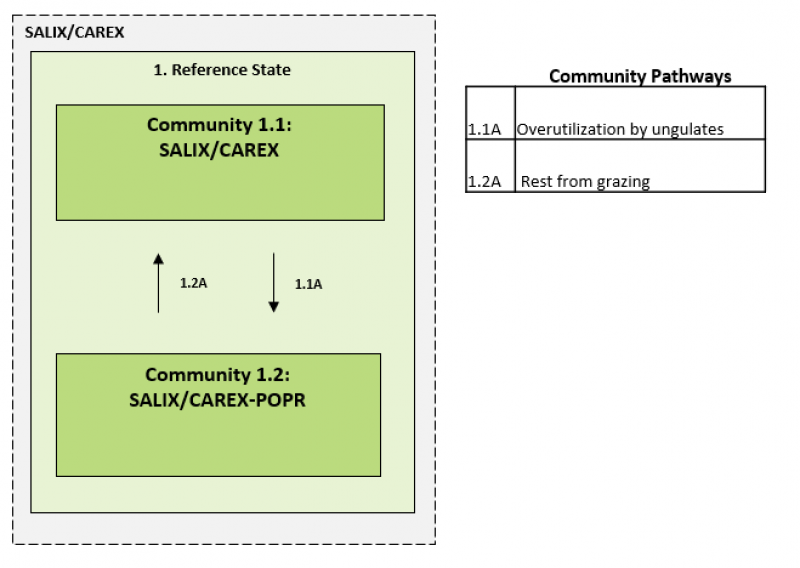
Natural Resources
Conservation Service
Ecological site R006XB102OR
Cold Wet Meadow
Last updated: 4/01/2025
Accessed: 12/20/2025
General information
Provisional. A provisional ecological site description has undergone quality control and quality assurance review. It contains a working state and transition model and enough information to identify the ecological site.
MLRA notes
Major Land Resource Area (MLRA): 006X–Cascade Mountains, Eastern Slope
Stretching from northern Washington to southern Oregon, the Cascade Mountains, and spans the entirety of the mountain slopes, foothills, elevated plateaus and valleys on the eastern slopes of the Cascade mountains. This MLRA is a transitional area between the Cascade Mountains to the west and the lower lying Columbia Basalt Plateau to the east. Situated in the rain shadow of the Cascade Crest, this MLRA receives less precipitation than portions of the cascades further west and greater precipitation than the basalt plateaus to the east. Geologically, the majority of the MLRA is dominated by Miocene volcanic rocks while the northern portion is dominated by Pre-Cretaceaus metamorphic rocks and the southern portion is blanketed with a thick mantle of ash and pumice from Mount Mazama. The soils in the MLRA dominantly have a mesic, frigid, or cryic soil temperature regime, a xeric soil moisture regime, and mixed or glassy mineralogy. They generally are moderately deep to very deep, well drained, and loamy or ashy. Biologically, the MLRA is dominated by coniferous forest, large expanses of which are dominated by ponderosa pine, Douglas-fir or lodgepole pine. Areas experiencing cooler and moister conditions include grand fir, white fir, and western larch while the highest elevations include pacific silver fir, subalpine fir and whitebark pine. Economically, timber harvest and recreation are important land uses in these forests. Historically, many of these forests would have experienced relatively frequent, low and mixed severity fire favoring the development of mature forests dominated by ponderosa pine or Douglas-fir. In the southern pumice plateau forests, less frequent, higher severity fire was common and promoted the growth of large expanses of lodgepole pine forests.
LRU notes
This broad group of sites encompasses meadow and riparian sites that occur across the MLRA. These sites range across MLRA 6 and span broad gradients of plant community composition, physiography, geology, and climate. These sites share common influences of adjacent riparian areas or wetlands and moist to wet soils with udic or aquic soil moisture regimes.
Classification relationships
Riparian Zone Associations of the Deschutes, Ochoco, Fremont, and Winema National Forests (Kovalchik 1987)
SW11-13 – Willow/Widefruit sedge
Riparian And Wetland Vegetation of Central and Eastern Oregon (Crowe et al. 2004)
CEGL001185 - Salix boothii-Salix geyeriana/Carex angustata (C. eurycarpa)
Ecological site concept
This site represents a wet meadow occurring within the foothills of the eastside of the Oregon Cascades. The reference plant community is dominated by a diversity of riparian willow (Salix spp.) species and an herbaceous layer dominated by various sedge (Carex spp.) species. In comparison to other meadow sites described in the area, this site is wetter and colder, experiencing moist soils throughout much of the year as well as occasional spring ponding. These conditions favor species with high moisture requirements and those adapted to an anoxic soil environment. Adjacent sites with lower water tables and less frequent ponding may be forested with lodgepole pine (Pinus contorta). The soil moisture regime is Aquic and the soil temperature regime is Cryic.
This is a provisional ecological site and is subject to extensive review and revision before final approval. All data herein should be considered provisional and contingent upon field validation prior to use in conservation planning.
Associated sites
| F006XY712OR |
Cryic Xeric Pumice Uplands 18-25 PZ occupying adjacent forested map units where no water table is present |
|---|---|
| F006XE807OR |
Cryic Aquic Pumice Basins (PICO/SPDO-VAUL) Occupying locations further from water bodies with lower water tables |
| F006XY718OR |
Cryic Xeric Pumice Basins 18-25 PZ occupying adjacent forested map units where no water table is present but where cold air pooling occurs |
Similar sites
| F006XY706OR |
Cryic Coniferous Flood Plain Occupying floodplains and low terraces along streams |
|---|---|
| R006XB100OR |
Wet Meadow Elevation below 3,500 feet, frigid soil temperature regime, dominated by tufted hairgrass |
| F006XE807OR |
Cryic Aquic Pumice Basins (PICO/SPDO-VAUL) Water table lower, forested with lodgepole |
Table 1. Dominant plant species
| Tree |
Not specified |
|---|---|
| Shrub |
(1) Salix |
| Herbaceous |
(1) Carex |
Click on box and path labels to scroll to the respective text.
Ecosystem states
State 1 submodel, plant communities
| 1.1A | - | Overutilization by ungulates |
|---|---|---|
| 1.2A | - | Rest from grazing |
